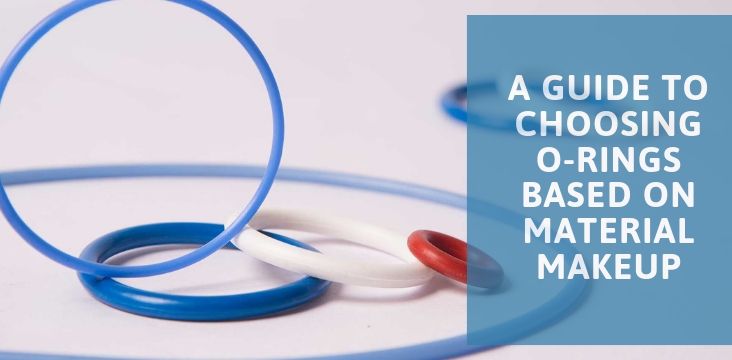A Guide to Choosing O-Rings Based on Material Makeup
O-rings are a common application in the manufacturing industry. Factors like cost, simple production, easy installation, and pressure resistance, allow wide application in common products, such as automobiles and engines. O-rings are commonly used in the aerospace industry in many types of rockets.
The diverse scope of material used in the fabrication of O-rings allows for wide application across industries. They are made from rubber, or, more specifically elastic polymers, or elastomers. These polymers are cured, often through the process of vulcanization, transforming them into stronger and highly durable elastic rubber. The material differs in terms of different properties i.e. some materials are more elastic while some are more tear resistant.
With the range of materials available, choosing the correct material as per the application can get confusing. Because of these polymers are cured, often through the process of vulcanization, transforming them into strong, durable and more elastic rubber. Keeping in mind the many efficiencies and deficiencies that can guide or influence that decision as well taking the help of designers and contractors can help make a decision, there are many efficiencies and deficiencies that can guide or influence that decision as well. Here are some of them:
- 1. Nitrile (Buna-N)
Temperature range: -65 degrees ºF – 300 degrees ºF .
Suited for: Buna-N is resistant to tears and abrasive treatment. These general purpose seal are best suited for petroleum oils, water, and some hydraulic fluids.Deficiencies: Problems can arise with automotive brake fluid, ketones, phosphate ester hydraulic fluids, and nitro and halogenated hydrocarbons. Even though it is ozone and weather resistant, this resistance is not infallible but can be supported through compounding.Applications: Nitrile works well for applications that have limited temperature and resistance requirements.
- 2. Ethylene Propylene Rubber (EPR)Temperature range: -65 degrees ºF and 300 degrees ºFSuited for: Skydrol, a hydraulic fluid with a noxious smell and can irritate the skin, and its corrosive properties can be damage equipment. EPR o-rings work well with Skydrol as well as other hydraulic fluids, as well as water, silicone oils, steam brake fluids, and alcohols.Deficiencies: Like Nitrile, EPR is not foolproof for a range of applications due to wear and tear issues.Applications: EPR o-rings are used in hydraulic pumps in the aerospace industry.
- 3. Fluorocarbon (Viton)Suited for: Fluorocarbon is an all-around material that can handle a number of applications, especially diverse sealing jobs that involve movement. It is also suited for petroleum oils, silicone fluids and gases, acids and some halogenated hydrocarbons, like carbon tetrachloride.Deficiencies: Fluorocarbon is not recommended for Skydrol, amines, esters, and ethers with low molecular weight and hot hydrofluoric acids.Applications: Fluorocarbon o-rings are very versatile, and features in many different automotive, appliance and chemical processing industries.
- 4. NeopreneTemperature range: -65 degrees ºF and 300 degrees ºF.Suited for: Neoprene seal refrigerants in refrigeration and air conditioner units, petroleum oils and mild acid resistance silicate ester lubricants.Deficiencies: Finished neoprene products are often compounded with lead-based agents, that could be hazardous to human health. Some people tend to be allergic to neoprene. It has a low resistance to petroleum lubricants and oxygen.Applications: Neoprene performs well in refrigeration units of air conditioning systems.
- 5. PolyurethaneTemperature range: Between -65 degrees ºF – 212 degrees ºF.Suited for: Polyurethane features abrasion and extrusion resistance, as well as general toughness.Deficiencies: Applications requiring good compression and heat resistance would not be suitable for polyurethane.Applications: Polyurethane o-rings are used for applications like hydraulic fittings, cylinders and valves, pneumatic tools, and firearms.
- 6. SiliconeTemperature range: -120 degrees ºF -450 degrees ºF, although silicone o-rings are known to withstand -175 degrees ºF during short periods of exposure.Deficiencies: Silicone means they are better suited for static applications than dynamic. They do perform well with water, steam or petroleum fluids, either.Applications: Silicone o-rings can be used in High-temperature fuel injection ports.
- 7. PTFETemperature range: -100 degrees ºF -500 degrees ºF.Suited for: PTFE encapsulated o-rings manage to handle surface wear well, as well as exhibiting corrosion and abrasion resistance, non-permeability, chemical inertness, and low absorption.Deficiencies: PTFE is rigid and best suited for static applications.Applications: PTFE O-ring applications include automotive steering devices and paint guns.








